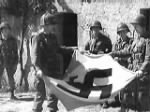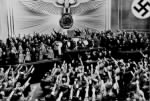A
fter World War I, Germany faced a time of depression and political upheaval that created a favorable environment for Hitler and the Nazi Party to take power. During his reign as Führer, Hitler strengthened the German economy and expanded the German Empire, but this aggressive strategy in Europe caused World War II and the deaths of millions of Jews and “undesirables” in concentration camps. The Nazi Reich taught the world how hatred and power could build up a nation, but would ultimately destroy it.
There are no facts with dates. Select Add to add facts or records.
Adolf Hitler
Chancellor, 1933-1945; Führer, 1934-1945
Karl Adolf Eichmann
headed Gestapo Department IV B4 for Jewish Affairs; “Jewish Specialist.”
Reinhard Heydrich
Second in SS organization, lead planner of Hitler’s Final Solution.
Hans Frank
Governor-General of Occupied Poland, perpetuated the Holocaust in Poland.
Martin Bormann
Head of the Party Chancellery and private secretary to Adolf Hitler.
Joseph Goebbels
Minister of Nazi Propaganda; succeeded Hitler as chancellor for one day; On May 1, 1945, he committed suicide
Rudolf Hess
Deputy Führer, number three after Göring.
Heinrich Himmler
Head of the German SS, Reichsführer-SS; committed suicide in Luneburg by potassium cyanide
Hermann Göring
President of the Reichstag, commander of the Luftwaffe (German Air Force), committed suicide after Nuremberg trials






